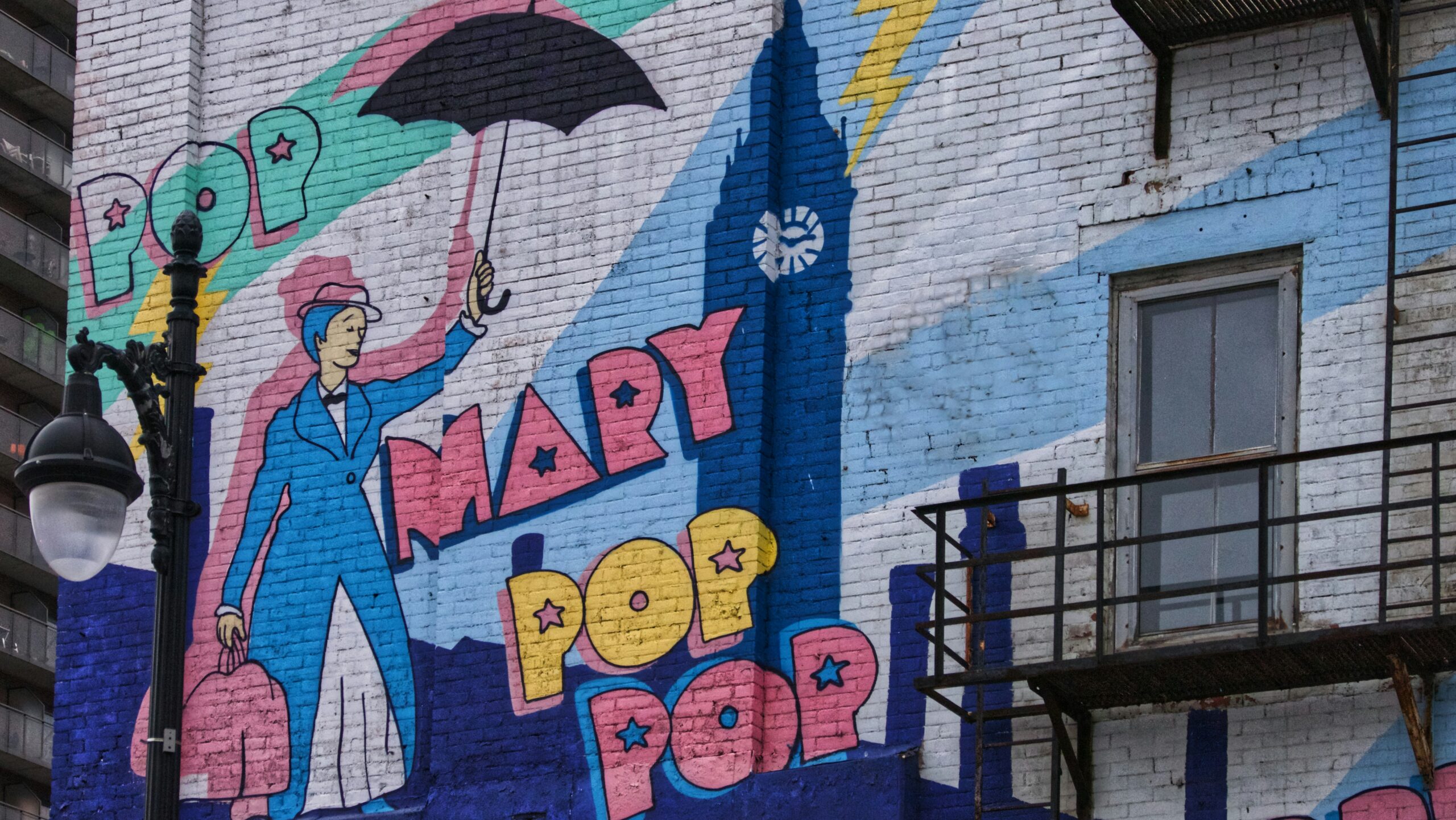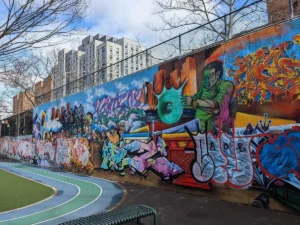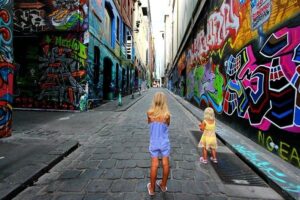Introduction to Street Art’s Cultural Impact
Street art, once a rebellious whisper on city walls, has become a booming voice in pop culture and mainstream media. From gritty graffiti tags to sprawling murals that stop pedestrians in their tracks, this art form has transformed urban landscapes and captured global attention. It’s no longer just vandalism—it’s a cultural force, blending creativity, activism, and accessibility. Let’s dive into how street art has woven itself into the fabric of modern media and society.
The Roots of Street Art
A Rebellious Beginning in the 1960s
Street art emerged in the 1960s and 1970s, born from the raw energy of urban youth. Graffiti pioneers like Cornbread in Philadelphia and Taki 183 in New York scrawled their names on walls, claiming space in cities that often ignored them. This wasn’t just art—it was a cry for recognition from marginalized communities, a way to protest social inequalities and assert identity. These early tags laid the foundation for a movement that would soon explode into global consciousness.
From Vandalism to Valid Art Form
What started as illegal scribbles faced harsh criticism and legal battles. But artists like Jean-Michel Basquiat and Keith Haring changed the game, blending raw urban energy with sophisticated techniques. Their work moved from alleyways to galleries, proving street art could be both rebellious and respected. Today, it’s celebrated as a legitimate art form, with cities designating legal walls for artists to create without fear of arrest.
Street Art’s Rise in Pop Culture
The Role of Social Media
Social media has been a game-changer for street art. Platforms like Instagram allow artists to share vibrant murals with millions, turning local creations into global sensations. A single hashtag—#StreetArt—can connect a mural in Miami to viewers in Tokyo. This accessibility has given artists like Banksy and Shepard Fairey unprecedented reach, making street art a staple in the digital age.
Street Art in Music and Fashion
Street art’s influence spills into music videos, album covers, and fashion lines. Think of Kanye West’s Yeezus album, with its minimalist graffiti-inspired aesthetic, or brands like Supreme collaborating with artists like KAWS. These crossovers blend urban grit with high-end appeal, making street art a cultural connector across industries. It’s not just art on walls—it’s a lifestyle.
Film and Television Embrace the Streets
Movies like Exit Through the Gift Shop and TV shows featuring urban backdrops have brought street art to mainstream screens. Documentaries showcase artists’ processes, while fictional series use murals as storytelling tools, reflecting community struggles or triumphs. This visibility has elevated street art from underground to prime time, cementing its place in pop culture.
Mainstream Media’s Love Affair with Street Art
Street Art in Advertising
Brands have caught on to street art’s cool factor. Companies like Nike and Adidas commission murals for campaigns, blending corporate messaging with urban authenticity. These collaborations often feature bold colors and social messages, resonating with younger audiences. However, some criticize this as commodifying a once-rebellious art form, raising questions about authenticity.
Art Galleries and Auctions
Street art has stormed the gallery world, with artists like Banksy fetching millions at auctions. Jean-Michel Basquiat’s Untitled sold for $110.5 million in 2017, a record for street art. Galleries now host exhibitions dedicated to urban artists, blurring the lines between public and fine art. This shift has made street art a hot commodity, but it’s also sparked debates about losing its anti-establishment roots.
Street Art Festivals and Global Events
Festivals like POW! WOW! in Hawaii and Nuart in Norway have turned cities into open-air galleries. These events draw artists and fans worldwide, showcasing diverse styles and fostering cultural exchange. They’ve also become media magnets, with coverage in art magazines and news outlets, amplifying street art’s mainstream presence. It’s a celebration of creativity that’s hard to ignore.
Why Street Art Resonates
Accessibility and Inclusivity
Unlike museum art, street art is free and open to all. You don’t need a ticket to experience a mural on your commute. This accessibility makes it a democratic art form, speaking to diverse audiences and reflecting real-world issues like racism or gentrification. It’s art for the people, by the people.
Activism and Social Commentary
Street art is a megaphone for social change. Murals often tackle heavy topics—think Banksy’s stencils on war or inequality. These works spark conversations, challenge norms, and give voice to the marginalized. For example, artist INTI’s murals blend Latin American folklore with critiques of societal transformation, resonating globally.
A Personal Connection
I remember stumbling across a mural in my hometown—a vibrant depiction of local history painted on a brick wall. It wasn’t just beautiful; it told a story of my community’s struggles and pride. That moment showed me street art’s power to connect on a personal level, turning a mundane walk into a meaningful experience. It’s this relatability that hooks viewers.
The Intersection with Pop Art
Blurring High and Low Culture
Street art and pop art share a rebellious spirit, challenging elitist art norms. Pop artists like Andy Warhol and Roy Lichtenstein borrowed from commercial imagery, much like street artists use urban spaces. Both movements critique consumerism and mass media, creating a bridge between high art and everyday life. This synergy has made street art a natural fit in pop culture.
Iconic Imagery and Techniques
Pop art’s bold colors and repetition, like Warhol’s silkscreened soup cans, echo in street art’s vibrant murals and stencils. Both use recognizable symbols—think comic strips or brand logos—to comment on society. This shared visual language makes street art instantly appealing, amplifying its pop culture presence.
Pros and Cons of Street Art’s Mainstream Rise
Benefits of Mainstream Recognition
- Global Exposure: Social media and media coverage give artists worldwide audiences.
- Financial Opportunities: Auctions and brand deals provide income for artists.
- Cultural Validation: Recognition in galleries elevates street art’s status.
- Community Impact: Murals beautify urban spaces and foster pride.
Challenges of Going Mainstream
- Loss of Authenticity: Commercialization can dilute the rebellious spirit.
- Gentrification Risks: Street art can attract development, pricing out locals.
- Legal Gray Areas: Despite acceptance, some works remain unsanctioned.
- Over-Saturation: Too much exposure risks making street art feel repetitive.
Comparison: Street Art vs. Traditional Art
| Aspect | Street Art | Traditional Art |
|---|---|---|
| Accessibility | Free, public, no entry barriers | Often requires museum or gallery access |
| Cost | Low or no cost to view | Tickets or purchases often required |
| Medium | Murals, graffiti, stencils | Paintings, sculptures, installations |
| Purpose | Social commentary, activism, expression | Aesthetic, personal, or commercial |
| Longevity | Often temporary, weather-dependent | Designed for preservation |
This table highlights why street art stands out—it’s accessible, raw, and tied to real-world issues, unlike the often exclusive world of traditional art.
Street Art’s Economic Impact
The Art Market Boom
Street art has reshaped the art market. Prints and multiples by artists like Keith Haring are now accessible through online platforms, making collecting easier. High-profile sales, like Banksy’s shredded Girl with Balloon, drive demand, with entry-level pieces attracting new collectors. This democratization has made art investment more inclusive.
Urban Revitalization
Murals can transform neglected neighborhoods into cultural hubs. Cities like Miami’s Wynwood district thrive on street art tourism, boosting local businesses. However, this can lead to gentrification, where rising property values displace original residents. It’s a double-edged sword—economic growth with social costs.
People Also Ask (PAA)
What is street art in pop culture?
Street art in pop culture refers to urban artworks like graffiti and murals influencing music, fashion, film, and media. It blends raw expression with mainstream appeal, often carrying social messages that resonate widely. Artists like Banksy have made it a global phenomenon through social media and brand collaborations.
How has street art influenced mainstream media?
Street art shapes mainstream media through advertising, films, and news coverage. Brands use murals for campaigns, while documentaries and TV shows highlight artists’ stories. Festivals and social media amplify this, making street art a visible part of modern culture.
Who are the most famous street artists?
Banksy, Jean-Michel Basquiat, Shepard Fairey, Keith Haring, and JR are among the most recognized. Their works, from political stencils to vibrant murals, have gained global fame through galleries, auctions, and social media. Each brings a unique voice to the movement.
Where can I find street art events?
Check festivals like POW! WOW! in Hawaii, Nuart in Norway, or local art walks in cities like Miami or Berlin. Websites like StreetArtNews.net or social media hashtags (#StreetArt, #UrbanArt) offer updates on events and exhibitions near you.
What are the best tools for creating street art?
- Spray Paint: Brands like Montana or Molotow offer vibrant, durable colors.
- Stencils: Pre-cut designs for precision, available on Etsy or custom-made.
- Markers: Posca pens for detailed tagging or sketching.
- Digital Tools: Apps like Procreate for planning designs before hitting the wall.
Controversies and Criticisms
Vandalism vs. Art Debate
Is it art or vandalism? Posts on X reflect this divide—some celebrate street art’s creativity, while others see it as defacing property. Legal walls have eased tensions, but unsanctioned works still spark controversy. This debate keeps street art edgy, fueling its cultural relevance.
Commercialization Concerns
As brands and galleries embrace street art, some fear it’s losing its soul. Critics argue that corporate murals or million-dollar auctions betray the art’s anti-establishment roots. Yet, artists like Haring made their work accessible, suggesting commercialization can coexist with authenticity if done thoughtfully.
The Future of Street Art
Emerging Trends and Technologies
New artists are pushing boundaries with digital media and augmented reality. Imagine murals that change with a smartphone scan—technology is expanding street art’s possibilities. Artists like INTI blend traditional techniques with modern themes, ensuring the movement stays dynamic.
A Call to Action
Street art’s future depends on us. Support local artists by visiting murals, attending festivals, or sharing their work online. Advocate for legal walls in your city to nurture creativity. By engaging with this art form, you’re not just a viewer—you’re part of a global movement.
FAQ
Is street art legal?
It depends. Unsanctioned art on private property is often illegal, but many cities offer legal walls or commission murals. Always check local laws before creating.
How do street artists make money?
Artists earn through commissions, gallery sales, prints, or brand collaborations. Online platforms like MyArtBroker simplify selling prints, while auctions fetch high prices for originals.
Can anyone create street art?
Yes, but it takes skill and respect for the craft. Start with legal walls, practice with stencils or sketches, and study local regulations to avoid trouble.
Why is street art so popular?
Its accessibility, bold visuals, and social messages resonate widely. Social media amplifies its reach, making it a cultural touchstone for diverse audiences.
Where can I learn more about street art?
Follow artists on Instagram, read blogs like StreetArtNews.net, or visit festivals. Documentaries like Exit Through the Gift Shop offer deep dives into the culture.
Conclusion
Street art has journeyed from alleyways to auction houses, weaving itself into pop culture and mainstream media with vibrant force. It’s more than paint on walls—it’s a voice for the unheard, a canvas for change, and a bridge between art and everyday life. As you walk through your city, look for those murals. They’re not just art—they’re stories waiting to be heard.








